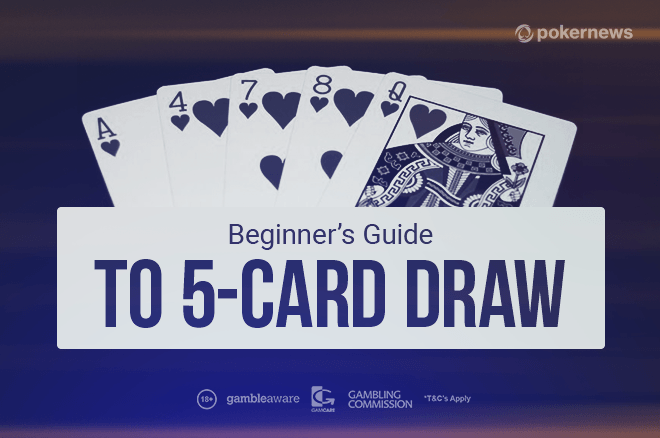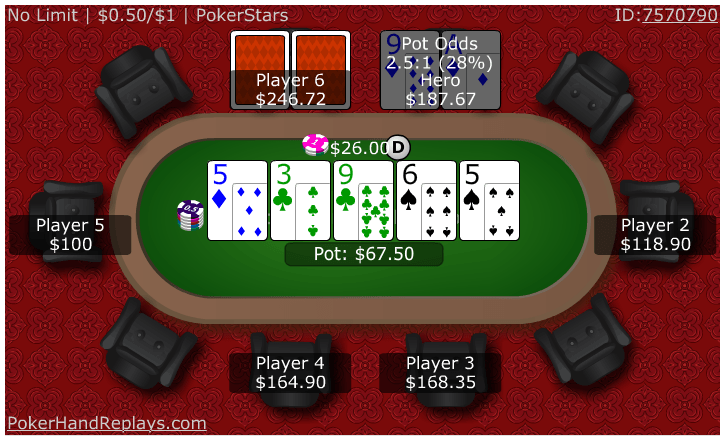Draw Poker Rules
Draw poker is a classic game that closely resembles the earliest known poker games. It was a home-game mainstay for centuries, but in just the last few years it has largely been replaced by Texas Hold’em. While Draw Poker games might be hard to find in poker rooms and casinos, they can offer a nice change from your normal routine and are perfect for entertaining guests. This game follows a simple betting structure and lends itself to players of any level. In fact, traditional five-card draw poker is perfect for people who are new to poker in general.
Rules for Playing Draw Poker
There are many variations of draw poker, but the big name is ‘fixed-limit five-card draw’. For this explanation, we will assume that the limits are $4/$8. Before you can start the game you need to designate the dealer position by using a dealer chip/button. To open up play, the player to the left of the dealer position must post the small blind ($2), and the player to their left must pay the big blind ($4). Sometimes in home games, instead of using blinds, every player must pay the designated ante (usually quite small) before any cards are dealt, or else they cannot play the hand.
Draw poker is any poker variant in which each player is dealt a complete hand before the first betting round, and then develops the hand for later rounds by replacing, or 'drawing', cards. 1 The descriptions below assume the reader is familiar with the general game play of poker, and with hand values (both high and low variations).
- Five card draw is one of the most common types of poker hands. Each player is dealt five cards, then a round of betting follows. Then each player may discard up to 3 cards (4 if your last card is an ace or wild card, in some circles) and get back (from the deck) as many cards as he/she discarded.
- Five-card draw (also known as a Cantrell draw) is a poker variant that is considered the simplest variant of poker, and is the basis for video poker. As a result, it is often the first variant learned by new players. It is commonly played in home games but rarely played in casino and tournament play.
Draw Poker Game Structure
Once the blinds have been posted, the dealer gives each player five cards face down. Players can inspect their hand and then the first round of betting starts. The player seated to the left of the big blind is the first to make a wager. This player can choose to fold his hand without paying anything, or ‘call’ by matching the $4 big blind. If this first player feels that they have a strong hand, they can raise an additional $4, making a total wager of $8. Play continues around the table to the left until everyone has either called all bets/raises, or folded. Since this is a fixed limit game, there is a three-raise maximum for any given betting round.

Once this first round of betting comes to a close, each player can choose to replace any of the cards in their deck. Starting with the player to the left of the dealer, each player removes and discards the cards from their hand that they want to replace. Once these cards have been removed, the same numbers of cards are dealt to them from the top of the deck. Each player can choose to replace any number of cards, ranging from no cards to all five.

After all players have completed their draw, the second and final round of betting can begin. This round of betting follows the same rules as the first but the limits increase. In a $4/$8 game, the limit for the second round is $8. Once this round has come to a close, it is time for the showdown. Each player shows their cards and the best five-card hand wins the entire pot. If there are two or more equally ranked hands, then the pot is split evenly among the winners. If you are unfamiliar with the traditional poker hand rankings, refer to the section below.
The Hand Rankings in Draw Poker Games
The Royal Flush– A suited ace-high straight.
Example: A K Q J T
Straight Flush – A suited straight.
Example: J T 9 8 7
Four of a Kind – Four equally ranked cards.
Example: 3 3 3 3 9
Full House – A hand including a ‘three of a kind’ and a pair.
Example: 4 4 4 8 8
Flush – Five cards from the same suit.
Example: 3 4 6 J Q
Straight – Five unsuited sequential cards.
Example: J T 9 8 7
Three of a Kind – Three equally ranked cards.
Example: T T T 6 2
Two Pair – Two separate pairs.
Example: 9 9 3 3 4
Pair – Two equally ranked cards.
Example: 4 4 9 J 7
High Card – If you do not have any of these hands then you go with your best card.
Example: 4 A K 5 7 In this case you would have ‘Ace High’.
Draw Poker Variations
No Limit and Pot Limit
So far we’ve assumed your five-card draw game would have fixed limits. While this is common, you should also know that there are no-limit and pot-limit variations to consider. In no limit draw, you can wager as much as you want as long as your wagers are greater than the big blind. In pot limit, the maximum wager is determined by the total size of the pot including the money that you would have to pay to call the current bet. In both no limit and pot limit, players commonly choose to go all-in, and play is much more volatile than in a fixed-limit game.
Double and Triple Draw
Traditional five-card draw has two rounds of betting: one before the draw, and one after. Double and Triple draw variations were designed for players who think each hand should last longer and develop more fully. For every draw you add, there is an additional, corresponding betting round. This means you will be playing for larger pots, and it will be more expensive to take a weak hand all the way to the showdown. Also additional draws lead to better, more refined hands. Other than these small differences though, the same rules apply. Double Draw and Triple Draw can be played with fixed limits, pot limit, or no limit.
LowBall Draw Poker

Tired of the tried and true five card draw game? Switching to lowball draw might be the perfect way to shake up your game and keep everything interesting. These games follow the same structure as normal games of draw poker but the hand rankings are completely different. To customize your game further, you can add a second or third draw to your lowball game or experiment with pot limit/no limit variations. If you have ever played other lowball poker games, you should understand how to determine winning low hands but if not, read on.
– Ace to Five Lowball
Commonly called California lowball, Aces to Five Lowball follows the standard low-game rules. You are looking for the lowest (traditionally worst) possible cards and straights/flushes are not counted against you. Also, aces act as the lowest cards in the deck. With these conditions, the best possible hand in this type of lowball is known as the wheel, and it consists of A2345 (suited or not). When determining the winner in this type of lowball game, you can generally ignore players with pairs, three of a kind, or four of a kind, unless no other players have a ‘traditionally worse’ hand. To start, compare every player’s highest card. The player with the lowest high card wins. In the somewhat likely event that two or more players have the same high card, you compare these players’ second highest cards. If there is still a tie, you compare their hands card by card until there is a clear winner. If your hand includes a pair, you must announce it. If you do not, you risk automatically losing if your silence causes others to misread your cards. In the event that two or more players hold the same hand, then the pot is split. See below for an example.
| Player | Hand | Highest Card |
| James | 2 4 9 Q Q | |
| Richard | 2 3 4 5 6 | 6 |
| Gemma | 3 6 7 9 J | |
| Pete | A 2 4 5 6 | 6 |
Using the hands in the example above, lets see who would win in an Aces to Five Lowball Draw game. As always, we look at everyone’s highest card. James’ and Gemma’s cards are much too high, so these players are quickly eliminated but Richard and Pete are tied for the lowest high card (6). They also both have the same second highest card (5), and third highest card (4), so the final call is up to their fourth highest cards. Richard has a 3, but Pete’s 2 is lower so Pete win’s the entire pot.
Five Draw Poker Rules
– Deuces to Seven Lowball
Also known as Kansas City Lowball, deuces to seven rewards its players for the worst possible poker hands (according to normal hand rankings). The lower your hand would normally rank, the higher it ranks in this game. Unlike hands in other lowball games, in Kansas City Lowball straights and flushes count against you, and aces remain high, so the best hand in deuces to seven, as the name suggests, is a 23457 non-suited. This variation is pretty popular in home games, but most casinos do not offer it.

Rules of Play
Double Draw Poker is played with a standard 52-card deck and 2 jokers. The jokers can be used as an Ace or to complete a straight or a flush. Players get two chances to draw cards to complete their 5-card poker hand.
- In Double Draw Poker, after the player makes an initial “Ante” bet and a mandatory “Bonus” bet, the cards are shuffled and each player is dealt five cards face down. After players views their five cards, they may choose to fold, forfeiting their “Ante” and “Bonus” bets ending their game.
- If players want to continue, they must make an additional “Draw Up to 3 Cards” bet equal in size to the “Ante” bet.
- Players now have the option of discarding up to three of their cards and drawing additional cards equal to the number of cards they discarded. The dealer will deal draw cards face down.
- Players again have the option to fold their hand and surrender all wagers placed thus far.
- If players want to continue, they must make another “Draw 1 Card” bet equal in size to the “Ante” bet and they now have the option of discarding one card from their hand and drawing an additional card, which the dealer will deal face down.
- The dealer will now turn the players five cards over and pay according to the following pay table:
| Hand | Bonus |
| Five Aces | 500 to 1 |
| Natural Royal Flush | 100 to 1 |
| Straight Flush | 50 to 1 |
| Four of a Kind | 20 to 1 |
| Full House | 5 to 1 |
| Flush | 3 to 1 |
| Straight | 2 to 1 |
| Three of a Kind | 1 to 1 |
| Two Pair | PUSH |
Ante and Draw bets pay 1 to 1 with Two Pair or better.